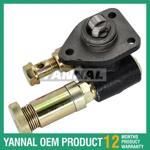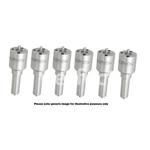Information injection-pump assembly
ZEXEL
101692-3620
1016923620
KOMATSU
6207711260
6207711260
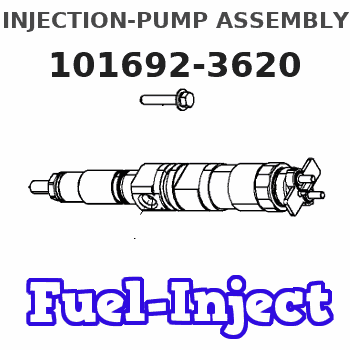
Rating:
Service parts 101692-3620 INJECTION-PUMP ASSEMBLY:
1.
_
5.
AUTOM. ADVANCE MECHANIS
6.
COUPLING PLATE
7.
COUPLING PLATE
8.
_
9.
_
11.
Nozzle and Holder
12.
Open Pre:MPa(Kqf/cm2)
19.6(200)
15.
NOZZLE SET
Cross reference number
ZEXEL
101692-3620
1016923620
KOMATSU
6207711260
6207711260
Zexel num
Bosch num
Firm num
Name
Calibration Data:
Adjustment conditions
Test oil
1404 Test oil ISO4113 or {SAEJ967d}
1404 Test oil ISO4113 or {SAEJ967d}
Test oil temperature
degC
40
40
45
Nozzle and nozzle holder
105780-8140
Bosch type code
EF8511/9A
Nozzle
105780-0000
Bosch type code
DN12SD12T
Nozzle holder
105780-2080
Bosch type code
EF8511/9
Opening pressure
MPa
17.2
Opening pressure
kgf/cm2
175
Injection pipe
Outer diameter - inner diameter - length (mm) mm 6-2-600
Outer diameter - inner diameter - length (mm) mm 6-2-600
Overflow valve opening pressure
kPa
157
123
191
Overflow valve opening pressure
kgf/cm2
1.6
1.25
1.95
Tester oil delivery pressure
kPa
157
157
157
Tester oil delivery pressure
kgf/cm2
1.6
1.6
1.6
Direction of rotation (viewed from drive side)
Right R
Right R
Injection timing adjustment
Direction of rotation (viewed from drive side)
Right R
Right R
Injection order
1-5-3-6-
2-4
Pre-stroke
mm
3.2
3.15
3.25
Rack position
Point A R=A
Point A R=A
Beginning of injection position
Drive side NO.1
Drive side NO.1
Difference between angles 1
Cal 1-5 deg. 60 59.5 60.5
Cal 1-5 deg. 60 59.5 60.5
Difference between angles 2
Cal 1-3 deg. 120 119.5 120.5
Cal 1-3 deg. 120 119.5 120.5
Difference between angles 3
Cal 1-6 deg. 180 179.5 180.5
Cal 1-6 deg. 180 179.5 180.5
Difference between angles 4
Cyl.1-2 deg. 240 239.5 240.5
Cyl.1-2 deg. 240 239.5 240.5
Difference between angles 5
Cal 1-4 deg. 300 299.5 300.5
Cal 1-4 deg. 300 299.5 300.5
Injection quantity adjustment
Adjusting point
A
Rack position
10.1
Pump speed
r/min
1025
1025
1025
Average injection quantity
mm3/st.
68.6
67.6
69.6
Max. variation between cylinders
%
0
-2.5
2.5
Basic
*
Fixing the lever
*
Injection quantity adjustment_02
Adjusting point
-
Rack position
8.2+-0.5
Pump speed
r/min
450
450
450
Average injection quantity
mm3/st.
12.5
11.5
13.5
Max. variation between cylinders
%
0
-15
15
Fixing the rack
*
Remarks
Adjust only variation between cylinders; adjust governor according to governor specifications.
Adjust only variation between cylinders; adjust governor according to governor specifications.
Test data Ex:
Governor adjustment
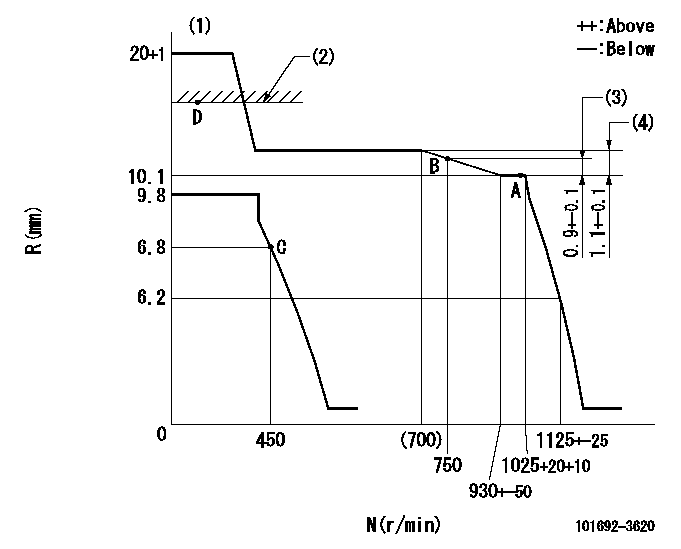
N:Pump speed
R:Rack position (mm)
(1)Target notch: K
(2)RACK CAP: R1
(3)Rack difference between N = N1 and N = N2
(4)Rack difference between N = N3 and N = N4
----------
K=15 R1=(17.5)mm N1=1025r/min N2=750r/min N3=1025r/min N4=350r/min
----------
----------
K=15 R1=(17.5)mm N1=1025r/min N2=750r/min N3=1025r/min N4=350r/min
----------
Speed control lever angle
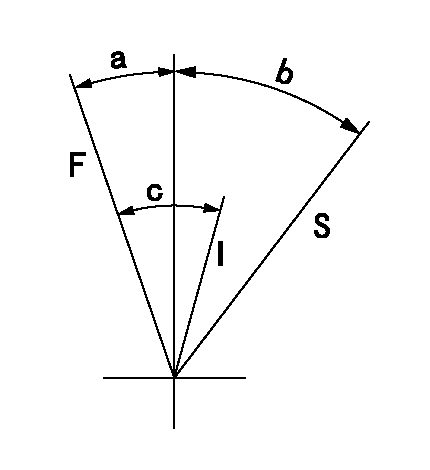
F:Full speed
I:Idle
S:Stop
----------
----------
a=12deg+-5deg b=32deg+-3deg c=31deg+-5deg
----------
----------
a=12deg+-5deg b=32deg+-3deg c=31deg+-5deg
Timing setting
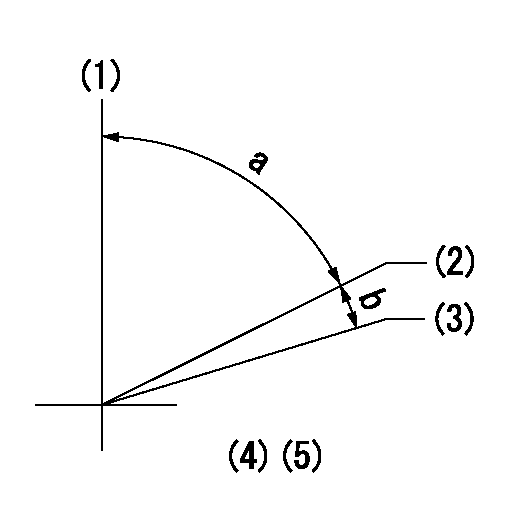
(1)Pump vertical direction
(2)Position of key groove at No 1 cylinder's beginning of injection
(3)Stamp aligning marks on the pump housing flange.
(4)-
(5)-
----------
----------
a=58deg+-3deg b=2deg+-30min
----------
----------
a=58deg+-3deg b=2deg+-30min
Information:
Recommended Coolant Mixture (Maintenance)
Monitor the coolant condition to determine it's proper life. Adding pure antifreeze as a makeup solution for cooling system top-off is an unacceptable practice. It increases the concentration of antifreeze in the cooling system which increases the concentration of dissolved solids and undissolved chemicals in the cooling system. Add antifreeze premixed with acceptable water to the same freeze protection as your cooling system. Use the chart below to assist in determining the concentration of antifreeze to use. Check the coolant solution frequently in cold weather for glycol concentration with the Caterpillar Coolant Tester to ensure adequate freeze protection. There are two testers available. Both testers are identical except temperature scale (one °C; one °F) and give immediate results for antifreeze/coolants that contain ethylene or propylene glycol. Both are available from Caterpillar.Commercial Antifreeze/Water Coolant Mixture
If propylene glycol based antifreeze is used, DO NOT allow concentration greater than a 50/50 antifreeze to water mixture. The measurement of freeze protection must be made with a refractive-type tester rather than a hydrometer-type (which can be used to test ethylene glycol based antifreeze). Use the concentration chart above for proper freeze protection.Liquid supplemental coolant additive must be added, when not using Caterpillar Antifreeze, which contains the proper additive.
Most commercial antifreezes are formulated for gasoline engine applications and will, therefore, have high silicate content. ASTM D4985-89 antifreeze is a low silicate antifreeze and should be used if not using Caterpillar Antifreeze. The percentage of antifreeze and water should be determined by the amount of freeze protection required. Follow the instructions provided by the antifreeze supplier.When using any antifreeze (except Caterpillar Antifreeze) liquid supplemental coolant additive is required at initial fill. Caterpillar or other manufacturer's products can be used as the liquid supplemental coolant additive.Add 2 liter (2 U.S. quart) of liquid supplemental coolant additive, or equivalent, for each 30 liter (8 U.S. gallon) so that the cooling system will have a 3% to 6% concentration of liquid supplemental coolant additive.DO NOT mix Caterpillar liquid Supplemental Coolant Additive (Conditioner) with the other products available; select a cooling system treatment and use it exclusively. If other than Caterpillar products are used as the liquid supplemental coolant additive, follow the manufacturers' recommendation for cooling system treatment and test evaluation.Liquid Supplemental Coolant Additive (Conditioner)
Never use antifreeze/water coolant only, except if Caterpillar Antifreeze is being used. No liquid supplemental coolant additive is needed on initial fill, but is necessary on a maintenance basis.Excessive liquid supplemental coolant additive greater than the maximum recommended 6%, together with concentrations of antifreeze greater than 60% can cause deposits to form and can result in radiator tube blockage, overheating, and/or water pump seal damage.
Caterpillar requires the use of Caterpillar liquid Supplemental Coolant Additive (Conditioner). Caterpillar Antifreeze does NOT require liquid supplemental coolant additive at initial fill, but IS necessary on a maintenance basis.Liquid supplemental coolant additive (conditioner) is necessary to prevent rust, scale, pitting and/or corrosion of engine parts that coolant comes in contact with. A 3 to 6 percent concentration
Monitor the coolant condition to determine it's proper life. Adding pure antifreeze as a makeup solution for cooling system top-off is an unacceptable practice. It increases the concentration of antifreeze in the cooling system which increases the concentration of dissolved solids and undissolved chemicals in the cooling system. Add antifreeze premixed with acceptable water to the same freeze protection as your cooling system. Use the chart below to assist in determining the concentration of antifreeze to use. Check the coolant solution frequently in cold weather for glycol concentration with the Caterpillar Coolant Tester to ensure adequate freeze protection. There are two testers available. Both testers are identical except temperature scale (one °C; one °F) and give immediate results for antifreeze/coolants that contain ethylene or propylene glycol. Both are available from Caterpillar.Commercial Antifreeze/Water Coolant Mixture
If propylene glycol based antifreeze is used, DO NOT allow concentration greater than a 50/50 antifreeze to water mixture. The measurement of freeze protection must be made with a refractive-type tester rather than a hydrometer-type (which can be used to test ethylene glycol based antifreeze). Use the concentration chart above for proper freeze protection.Liquid supplemental coolant additive must be added, when not using Caterpillar Antifreeze, which contains the proper additive.
Most commercial antifreezes are formulated for gasoline engine applications and will, therefore, have high silicate content. ASTM D4985-89 antifreeze is a low silicate antifreeze and should be used if not using Caterpillar Antifreeze. The percentage of antifreeze and water should be determined by the amount of freeze protection required. Follow the instructions provided by the antifreeze supplier.When using any antifreeze (except Caterpillar Antifreeze) liquid supplemental coolant additive is required at initial fill. Caterpillar or other manufacturer's products can be used as the liquid supplemental coolant additive.Add 2 liter (2 U.S. quart) of liquid supplemental coolant additive, or equivalent, for each 30 liter (8 U.S. gallon) so that the cooling system will have a 3% to 6% concentration of liquid supplemental coolant additive.DO NOT mix Caterpillar liquid Supplemental Coolant Additive (Conditioner) with the other products available; select a cooling system treatment and use it exclusively. If other than Caterpillar products are used as the liquid supplemental coolant additive, follow the manufacturers' recommendation for cooling system treatment and test evaluation.Liquid Supplemental Coolant Additive (Conditioner)
Never use antifreeze/water coolant only, except if Caterpillar Antifreeze is being used. No liquid supplemental coolant additive is needed on initial fill, but is necessary on a maintenance basis.Excessive liquid supplemental coolant additive greater than the maximum recommended 6%, together with concentrations of antifreeze greater than 60% can cause deposits to form and can result in radiator tube blockage, overheating, and/or water pump seal damage.
Caterpillar requires the use of Caterpillar liquid Supplemental Coolant Additive (Conditioner). Caterpillar Antifreeze does NOT require liquid supplemental coolant additive at initial fill, but IS necessary on a maintenance basis.Liquid supplemental coolant additive (conditioner) is necessary to prevent rust, scale, pitting and/or corrosion of engine parts that coolant comes in contact with. A 3 to 6 percent concentration
